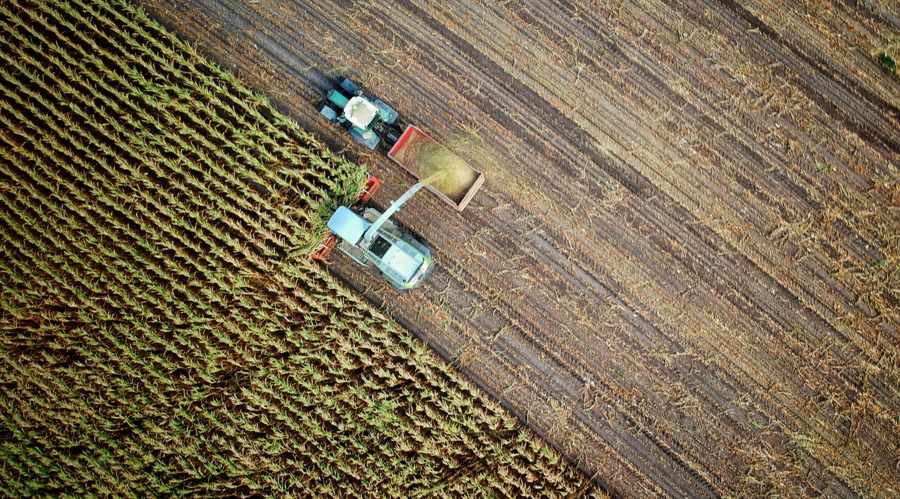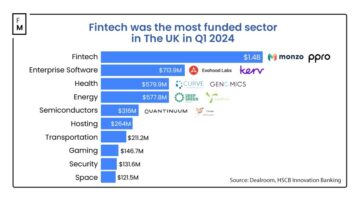
A digital
revolution is taking place in the agricultural heartland. Fintech, or the
marriage of finance and technology, has crossed traditional borders to change
industries, including agriculture.
Farmers are
leveraging the power of fintech to alter the way they handle finances, access
credit, and optimize operations as demand on the global food supply chain grows
and sustainability becomes more important. This article delves into the collision
between finance and agriculture, looking at how digital platforms are
empowering farmers and transforming an age-old business.
Agriculture,
the backbone of economies and a vital source of food, has entered a new era.
Fintech, powered by technology and driven by innovation, is reshaping the
agricultural environment. Digital platforms are offering farmers with
technologies that streamline financial operations, bridge loan access, and
improve overall efficiency, from distant villages to large fields. The
convergence of fintech and agriculture is about more than just financial
transactions; it is about changing the way farmers approach their livelihoods.
Fintechs to Reshape
Agricultural Finance: Seizing Untapped Potential
Beyond farming, the
agricultural sector supports food manufacturing, textiles, forestry, and more. Moreover,
emerging economies often rely on agriculture for up to a quarter of their
economic activity.
However, the
agricultural sector remains financially underserved, with 90% of
transactions still reliant on paper checks. Small community banks handle 70% of
agricultural lending, but their numbers have dwindled. This gap sets the stage
for fintech intervention.
Fintechs wield the
technological advantage needed to revolutionize agricultural finance:
- Modernized Payments: Fintechs can replace outdated paper checks, improving transaction efficiency.
- Commodities Pricing and Trading: Tech-enabled accurate pricing mitigates the impact of volatile weather patterns.
- Innovative Insurance: Advanced technology enables precise assessment of weather-related risks, enhancing climate insurance offerings.
- Efficient Marketplaces: Fintechs digitize farmer-buyer interactions, streamlining a traditionally offline process.
Key fintech players have
emerged in agricultural digital banking:
- Tillable (US): Collaborating with Evergreen Bank, Tillable offers diverse financial services for farmland.
- Oxbury (UK): Oxbury extends lending and savings services to British farmers.
- World Cover (Global): World Cover employs satellite technology for climate insurance in emerging markets.
- Twiga (Kenya): Twiga facilitates direct connections between farmers and buyers.
The digital transformation of
agricultural finance by fintechs promises increased accessibility and
efficiency. As fintechs continue to innovate, agriculture’s pivotal role in
economies will be bolstered, benefiting farmers and the broader financial
landscape.
Financial
Services Availability
Access to
traditional financial services is limited in many places of the world. Rural
farmers, who are frequently excluded from mainstream banking networks, confront
difficulties managing their finances, obtaining credit, and guaranteeing their
futures. Fintech platforms have stepped in to fill the void, providing mobile
banking solutions that allow farmers to conduct transactions, save money, and
access financial services via their cellphones.
Mobile
Transactions and Payments
The concept of
digital payments has been brought to the agricultural sector through fintech.
Farmers can use mobile money platforms to make and receive payments in real
time, even in distant places with minimal banking infrastructure. This improves
convenience while also lowering the hazards involved with carrying cash.
Crop
Insurance and Risk Management
Agriculture is
inherently vulnerable to risks ranging from weather to market volatility. To
provide novel crop insurance solutions, fintech platforms are integrating data
analytics and satellite images. These platforms assess risks and provide
coverage suited to individual farmers’ requirements. Farmers can obtain
compensation through digital channels in the event of poor weather conditions
or crop failure, reducing financial losses.
Credit
Availability
Credit
availability is a significant aspect in agricultural development. Alternative
data sources are being used by fintech platforms to measure creditworthiness in
addition to traditional credit scores. These platforms enable farmers to get
loans for seeds, equipment, and other necessities by assessing criteria such as
yield history, weather patterns, and market trends.
Crowdfunding
and peer-to-peer lending
Platforms for
peer-to-peer lending and crowdfunding are changing the way farmers access cash.
These platforms connect farmers with investors directly, eliminating
intermediaries and lowering the expenses associated with traditional loans.
Farmers can pitch their initiatives, share their stories, and seek money from a
global pool of investors that believe in sustainable agriculture’s promise.
Transparency
and traceability in the supply chain
Today’s consumers
expect openness in the origin and route of their food. By embracing blockchain
technology, fintech is improving supply chain transparency. Farmers can track
the transit of their goods from farm to fork using blockchain-powered
technologies. This not only assures the authenticity of the products, but it
also promotes fair trade and ethical sourcing.
Agriculture
Precision and Data Analytics
Fintech goes
beyond financial transactions to include data-driven insights that improve
agricultural operations. Precision agriculture platforms monitor soil health,
weather patterns, and crop growth using data analytics, sensors, and satellite
imaging. Farmers may make more informed irrigation, fertilization, and pest
management decisions, thereby enhancing productivity and sustainability.
E-commerce
and Market Access
Through
e-commerce, digital channels connect farmers to larger markets. Farmers can
promote their products online, reaching consumers outside of their immediate
regions. Farmers will be able to command fair pricing for their products as
market access is democratized, reducing the power of intermediaries.
Resource
Management and Sustainability
Fintech
solutions are supporting the worldwide push for sustainability. Data analytics
are being integrated into platforms to improve resource management. Farmers may
cut waste, reduce their carbon footprint, and contribute to sustainable
agricultural practices by reducing their water and energy consumption.
The Road
Ahead and the Challenges
While the incorporation
of finance into agriculture has enormous promise, obstacles remain. To provide
fair access and protection for all stakeholders, digital literacy,
infrastructure restrictions, and data privacy concerns must be addressed.
Collaboration among fintech firms, agricultural experts, and legislators is
critical to create an environment in which technology promotes beneficial
change.
Conclusion
The combination
of finance and agriculture signifies a watershed moment in an industry that
feeds nations. Digital platforms are democratizing financial services,
increasing efficiency, and promoting agricultural sustainability. The
agriculture sector is positioned for a more inclusive, resilient, and digitally
empowered future as farmers embrace the power of fintech to tackle difficulties
and uncover opportunities. Agriculture is not only adapting to the digital age;
it is embracing it to ensure a more profitable future.
A digital
revolution is taking place in the agricultural heartland. Fintech, or the
marriage of finance and technology, has crossed traditional borders to change
industries, including agriculture.
Farmers are
leveraging the power of fintech to alter the way they handle finances, access
credit, and optimize operations as demand on the global food supply chain grows
and sustainability becomes more important. This article delves into the collision
between finance and agriculture, looking at how digital platforms are
empowering farmers and transforming an age-old business.
Agriculture,
the backbone of economies and a vital source of food, has entered a new era.
Fintech, powered by technology and driven by innovation, is reshaping the
agricultural environment. Digital platforms are offering farmers with
technologies that streamline financial operations, bridge loan access, and
improve overall efficiency, from distant villages to large fields. The
convergence of fintech and agriculture is about more than just financial
transactions; it is about changing the way farmers approach their livelihoods.
Fintechs to Reshape
Agricultural Finance: Seizing Untapped Potential
Beyond farming, the
agricultural sector supports food manufacturing, textiles, forestry, and more. Moreover,
emerging economies often rely on agriculture for up to a quarter of their
economic activity.
However, the
agricultural sector remains financially underserved, with 90% of
transactions still reliant on paper checks. Small community banks handle 70% of
agricultural lending, but their numbers have dwindled. This gap sets the stage
for fintech intervention.
Fintechs wield the
technological advantage needed to revolutionize agricultural finance:
- Modernized Payments: Fintechs can replace outdated paper checks, improving transaction efficiency.
- Commodities Pricing and Trading: Tech-enabled accurate pricing mitigates the impact of volatile weather patterns.
- Innovative Insurance: Advanced technology enables precise assessment of weather-related risks, enhancing climate insurance offerings.
- Efficient Marketplaces: Fintechs digitize farmer-buyer interactions, streamlining a traditionally offline process.
Key fintech players have
emerged in agricultural digital banking:
- Tillable (US): Collaborating with Evergreen Bank, Tillable offers diverse financial services for farmland.
- Oxbury (UK): Oxbury extends lending and savings services to British farmers.
- World Cover (Global): World Cover employs satellite technology for climate insurance in emerging markets.
- Twiga (Kenya): Twiga facilitates direct connections between farmers and buyers.
The digital transformation of
agricultural finance by fintechs promises increased accessibility and
efficiency. As fintechs continue to innovate, agriculture’s pivotal role in
economies will be bolstered, benefiting farmers and the broader financial
landscape.
Financial
Services Availability
Access to
traditional financial services is limited in many places of the world. Rural
farmers, who are frequently excluded from mainstream banking networks, confront
difficulties managing their finances, obtaining credit, and guaranteeing their
futures. Fintech platforms have stepped in to fill the void, providing mobile
banking solutions that allow farmers to conduct transactions, save money, and
access financial services via their cellphones.
Mobile
Transactions and Payments
The concept of
digital payments has been brought to the agricultural sector through fintech.
Farmers can use mobile money platforms to make and receive payments in real
time, even in distant places with minimal banking infrastructure. This improves
convenience while also lowering the hazards involved with carrying cash.
Crop
Insurance and Risk Management
Agriculture is
inherently vulnerable to risks ranging from weather to market volatility. To
provide novel crop insurance solutions, fintech platforms are integrating data
analytics and satellite images. These platforms assess risks and provide
coverage suited to individual farmers’ requirements. Farmers can obtain
compensation through digital channels in the event of poor weather conditions
or crop failure, reducing financial losses.
Credit
Availability
Credit
availability is a significant aspect in agricultural development. Alternative
data sources are being used by fintech platforms to measure creditworthiness in
addition to traditional credit scores. These platforms enable farmers to get
loans for seeds, equipment, and other necessities by assessing criteria such as
yield history, weather patterns, and market trends.
Crowdfunding
and peer-to-peer lending
Platforms for
peer-to-peer lending and crowdfunding are changing the way farmers access cash.
These platforms connect farmers with investors directly, eliminating
intermediaries and lowering the expenses associated with traditional loans.
Farmers can pitch their initiatives, share their stories, and seek money from a
global pool of investors that believe in sustainable agriculture’s promise.
Transparency
and traceability in the supply chain
Today’s consumers
expect openness in the origin and route of their food. By embracing blockchain
technology, fintech is improving supply chain transparency. Farmers can track
the transit of their goods from farm to fork using blockchain-powered
technologies. This not only assures the authenticity of the products, but it
also promotes fair trade and ethical sourcing.
Agriculture
Precision and Data Analytics
Fintech goes
beyond financial transactions to include data-driven insights that improve
agricultural operations. Precision agriculture platforms monitor soil health,
weather patterns, and crop growth using data analytics, sensors, and satellite
imaging. Farmers may make more informed irrigation, fertilization, and pest
management decisions, thereby enhancing productivity and sustainability.
E-commerce
and Market Access
Through
e-commerce, digital channels connect farmers to larger markets. Farmers can
promote their products online, reaching consumers outside of their immediate
regions. Farmers will be able to command fair pricing for their products as
market access is democratized, reducing the power of intermediaries.
Resource
Management and Sustainability
Fintech
solutions are supporting the worldwide push for sustainability. Data analytics
are being integrated into platforms to improve resource management. Farmers may
cut waste, reduce their carbon footprint, and contribute to sustainable
agricultural practices by reducing their water and energy consumption.
The Road
Ahead and the Challenges
While the incorporation
of finance into agriculture has enormous promise, obstacles remain. To provide
fair access and protection for all stakeholders, digital literacy,
infrastructure restrictions, and data privacy concerns must be addressed.
Collaboration among fintech firms, agricultural experts, and legislators is
critical to create an environment in which technology promotes beneficial
change.
Conclusion
The combination
of finance and agriculture signifies a watershed moment in an industry that
feeds nations. Digital platforms are democratizing financial services,
increasing efficiency, and promoting agricultural sustainability. The
agriculture sector is positioned for a more inclusive, resilient, and digitally
empowered future as farmers embrace the power of fintech to tackle difficulties
and uncover opportunities. Agriculture is not only adapting to the digital age;
it is embracing it to ensure a more profitable future.
- SEO Powered Content & PR Distribution. Get Amplified Today.
- PlatoData.Network Vertical Generative Ai. Empower Yourself. Access Here.
- PlatoAiStream. Web3 Intelligence. Knowledge Amplified. Access Here.
- PlatoESG. Automotive / EVs, Carbon, CleanTech, Energy, Environment, Solar, Waste Management. Access Here.
- PlatoHealth. Biotech and Clinical Trials Intelligence. Access Here.
- ChartPrime. Elevate your Trading Game with ChartPrime. Access Here.
- BlockOffsets. Modernizing Environmental Offset Ownership. Access Here.
- Source: https://www.financemagnates.com//fintech/fintech-in-agriculture-how-digital-platforms-are-empowering-farmers/
- :has
- :is
- :not
- $UP
- a
- Able
- About
- access
- accessibility
- accurate
- activity
- addition
- addressed
- advanced
- Advanced Technology
- ADvantage
- age
- age-old
- Agricultural
- agriculture
- ahead
- All
- allow
- also
- alternative
- among
- an
- analytics
- and
- approach
- ARE
- article
- AS
- aspect
- assess
- Assessing
- assessment
- associated
- assures
- At
- attendees
- authenticity
- availability
- await
- Backbone
- Bank
- Banking
- Banks
- banner
- BE
- becomes
- been
- being
- believe
- beneficial
- benefiting
- between
- Beyond
- blockchain
- blockchain-powered
- borders
- BRIDGE
- British
- broader
- brought
- business
- but
- buyers
- by
- CAN
- carbon
- carbon footprint
- carrying
- Cash
- chain
- change
- changing
- channels
- Checks
- Climate
- collaborating
- collaboration
- combination
- community
- community banks
- Compensation
- concept
- Concerns
- conditions
- Conduct
- Connect
- Connections
- Consumers
- consumption
- continue
- contribute
- convenience
- Convergence
- cover
- coverage
- create
- credit
- creditworthiness
- criteria
- critical
- crop
- Crossed
- Crowdfunding
- Cut
- cutting-edge
- data
- Data Analytics
- data privacy
- data-driven
- decisions
- Demand
- democratized
- Democratizing
- Development
- difficulties
- digital
- digital age
- digital banking
- Digital Payments
- digital platforms
- Digital Transformation
- digitally
- digitize
- direct
- directly
- Distant
- diverse
- don
- Don't miss
- driven
- e-commerce
- Economic
- economies
- efficiency
- eliminating
- embrace
- embracing
- emerged
- emerging
- emerging markets
- employs
- empowered
- empowering
- enable
- enables
- energy
- Energy Consumption
- enhancing
- enormous
- ensure
- entered
- Environment
- equipment
- Era
- ethical
- Even
- Event
- Evergreen
- excluded
- exhibitors
- expect
- expenses
- expert
- Expert Insights
- experts
- extends
- facilitates
- Failure
- fair
- Fair Trade
- farm
- farmers
- farming
- farmland
- Fields
- fill
- finance
- Finances
- financial
- financial services
- financially
- fintech
- fintechs
- firms
- food
- food supply
- food supply chain
- Footprint
- For
- Forbes
- fork
- frequently
- from
- future
- Futures
- gap
- get
- Global
- Goes
- goods
- Grows
- Growth
- handle
- Have
- Health
- Heartland
- history
- How
- HTTPS
- images
- Imaging
- immediate
- Impact
- important
- improve
- improves
- improving
- in
- include
- Including
- Inclusive
- increased
- increasing
- individual
- industries
- industry
- informed
- Infrastructure
- inherently
- initiatives
- innovate
- Innovation
- innovations
- insights
- insurance
- integrated
- Integrating
- interactions
- intermediaries
- intervention
- into
- Investors
- involved
- IT
- jpg
- just
- kenya
- landscape
- large
- larger
- legislators
- lending
- leveraging
- Limited
- literacy
- loan
- Loans
- London
- looking
- losses
- lowering
- Mainstream
- make
- management
- managing
- manufacturing
- many
- Market
- Market Trends
- market volatility
- marketplaces
- Markets
- May..
- measure
- minimal
- Mobile
- Mobile money
- moment
- money
- Monitor
- more
- Moreover
- must
- Nations
- necessities
- needed
- networking
- networks
- New
- novel
- numbers
- obstacles
- obtain
- obtaining
- of
- offering
- Offerings
- Offers
- offline
- often
- on
- online
- only
- Openness
- Operations
- opportunities
- Optimize
- or
- Origin
- Other
- outside
- overall
- Paper
- patterns
- payments
- peer to peer
- peer-to-peer lending
- Pitch
- pivotal
- Place
- Places
- Platforms
- plato
- Plato Data Intelligence
- PlatoData
- players
- pool
- poor
- positioned
- power
- powered
- practices
- precise
- Precision
- premier
- pricing
- privacy
- process
- productivity
- Products
- profitable
- promise
- promises
- promote
- promotes
- promoting
- protection
- provide
- providing
- Push
- Quarter
- ranging
- reaching
- real
- receive
- reduce
- reducing
- regions
- register
- rely
- remain
- remains
- replace
- Requirements
- reshape
- resilient
- resource
- restrictions
- Revolution
- revolutionize
- Risk
- risks
- road
- Role
- Route
- Rural
- s
- satellite
- Save
- Savings
- scores
- sector
- seeds
- Seek
- sensors
- Services
- Sets
- Share
- significant
- signifies
- small
- soil
- Solutions
- Source
- Sources
- Sourcing
- speakers
- Stage
- stakeholders
- Still
- Stories
- streamline
- streamlining
- such
- supply
- supply chain
- supply chain transparency
- Supporting
- Supports
- Sustainability
- sustainable
- T
- tackle
- taking
- tech-enabled
- technological
- Technologies
- Technology
- textiles
- than
- that
- The
- the world
- their
- thereby
- These
- they
- this
- Through
- time
- to
- Traceability
- track
- trade
- Trading
- traditional
- traditionally
- transaction
- Transactions
- Transformation
- transforming
- transit
- Transparency
- Trends
- Uk
- uncover
- unmatched
- untapped
- us
- use
- used
- using
- via
- vital
- volatile
- Volatility
- Vulnerable
- Waste
- Water
- Way..
- Weather
- weather patterns
- which
- while
- WHO
- wield
- will
- with
- world
- worldwide
- Yield
- you
- zephyrnet





